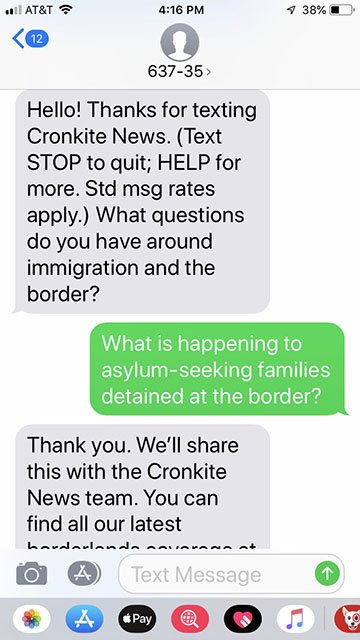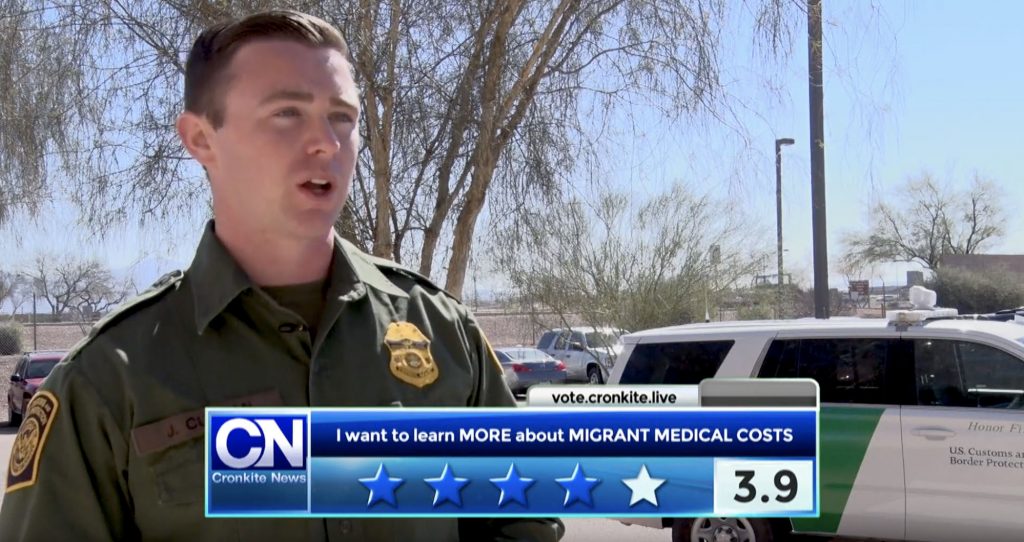NOTE: This case study is one in a series of news ‘experiments’ done by journalism students in the Cronkite Newsroom. Thanks to a grant from the Knight Foundation, the results are shared here on the Knight-Cronkite News Lab for the benefit of local TV newsrooms across the country.
What would happen if, for one day, you let your audience decide which stories you covered and the depth of treatment they received, and included the audience’s voice in that coverage? I’m not talking about gimmicks like letting the audience vote on whether the ‘kicker’ story should be the cute puppy video or the water-skiing squirrel (but, for what it’s worth, the water-skiing squirrel gets my vote every time!) I’m talking about empowering your audience to make meaningful decisions about substantive stories and your approach to coverage.
What We Did: ‘Choose Your News’
Students produce a 30-minute newscast every weekday that airs at 5 p.m. on Arizona PBS in Phoenix. On Tuesday, April 23rd, the big difference was that the program was live and the students at the ASU Cronkite School of Journalism produced a 30-minute live ‘Choose Your News’ special for Arizona PBS where we challenged ourselves to give our audience a meaningful voice in shaping the entire trajectory of the newscast.
We divided our broadcast into three segments, each informed by audience involvement. We also employed four engagement tools – GroundSource, MegaphoneTV, Twitter and Tagboard – to help empower the audience. Leading up to the broadcast, we prepared three enterprise reports for the first segment that were chosen with audience input. Then we used live voting to determine what happened next in the show. Ultimately, to account for all the possible choices the audience could make, we had to produce the equivalent of three full shows worth of content. This was not wasted work. We always knew the unaired ‘story journeys’ would be published online as our digital ‘Choose Your News’ experience.

Why ‘Choose Your News’
Our core goal was to go beyond mere token ‘audience engagement.’ We wanted to explore what would happen if we gave the audience a non-trivial voice in our editorial process. At the same time, we wanted to find a way to empower the audience without giving up our journalistic standards and rigor.
In the process, we also wanted to test different kinds of engagement tools to evaluate their ease of use both for us as journalists, and for our viewers and users; and to assess their relative effectiveness at bringing in the voice of the audience.
Finally, as a journalism school, our overriding goal in everything we do is to create a valuable learning experience for our students. The ‘Choose Your News’ experiment was intended specifically to empower our students to stretch their skills at engaging with the audience in a more direct and meaningful way.
‘Choose Your News’: How We Did It
We divided our 30-minute broadcast into three distinct blocks. Each show block featured a different audience engagement technique: The first segment used live audience voting to determine what story would air in the second block; during the second block, we solicited real-time social reaction; and in the third segment, we featured the ‘voice’ of the audience, including live curation of comments from social media.
The process of involving the audience in key editorial decisions started weeks in advance. We decided to feature three enterprise reports in our first segment. We wanted to ‘source’ those stories from the audience, while also applying our editorial standards. Two weeks in advance, we used the interactive texting tool GroundSource to solicit story ideas from viewers in three areas where we have dedicated beat reporters: Sustainability, Health and Borderlands.

We mixed those suggestions with enterprise stories pitched by reporters on those beats, and then created a Twitter poll for each vertical. Over the course of a week, our audience voted on which story we should produce in each of the three subject areas (Sustainability, Health and Borderlands.) We were delighted to receive hundreds of votes, and used this feedback to choose the three featured enterprise stories that made up our first segment.
Choose your news! ?
POLL: Which Arizona sustainability story would interest you the most?
— Cronkite News (@cronkitenews) April 5, 2019
At the start of our broadcast, we explained to viewers that the three featured stories were the ones they chose. We then let them know that, in the second segment of the show, we’d explore one of these three topics in-depth with a one-on-one interview with a subject-matter expert. The audience would decide which one via live voting enabled by MegaphoneTV.

As each story aired, a live rating displayed in real time as viewers voted on a scale of 1-5 stars the degree to which “I want to know MORE about this story”. Without spoiling the outcome for those who want to watch on-demand below, I can say we were pleased to see that the average “interest” rating was nearly a four out of five.
Of course, we had no way to know in advance which topic the audience would choose for the in-depth interview. So we had to produce three possible versions; each reporter, in addition to the enterprise story, prepared a five-minute one-on-one interview, and our producer built all three options into the show rundown, ready to drop the two that were not chosen.
During that second segment, while the deep-dive interview aired, we kept an on-screen call to action inviting our viewers to join the conversation and share their comments on Twitter via the hashtag #CNrealtalk. A second producer was dedicated to using Tagboard to engage in live curation of the social response.
Because we could not be sure what kind of live social response we’d get, we also prepared a more tradition ‘MOS’ method of including the voice of the audience. Since we already knew the subjects of the three possible story paths, we send three producers out to shoot separate ‘Community Voices’ segments and edited those together as short reaction videos. In our third segment, we aired the community voices video for the topic chosen by viewers, and then we displayed social comments as well.
Since we created three possible show ‘journeys’ and only one aired, our digital team created an online version of ‘Choose Your News’ and, at the end of the broadcast, we directed viewers to our website where they could choose a different story and see the in-depth interview and community voices for each of the other two options. And, we kept the conversation going by using GroundSource to once again invite suggestions for future story coverage. Here is the Choose Your News digital experience.
Results
Overall, students and faculty considered ‘Choose Your News’ a successful engagement experiment. From a measurement standpoint, we received above-average participation in the Twitter polls we used to select the three enterprise stories; we had more than 200 concurrent unique users voting live during our ‘choose the follow-up’ segment; and despite a narrow seven-minute window to solicit audience comments, we received a number of high-quality comments via social media. Our social posts related to the special show also significantly over-indexed compared to the daily averages for Cronkite News.
Arguably our biggest ‘result’ wasn’t measurable in any number. But you could feel it in the air. There was an undeniable electricity in the days and hours leading up to the special. The project involved students and faculty leaders from every part of the newsroom – and was energizing to all. This organic post to social media captures the excitement and camaraderie created by this innovation effort.
Actual footage of @Nicole_H102 & I waiting for our talented anchors @bobbykraus22 & @TaylorRochaTV to reveal the winner of today’s #ChooseYourNews show.
Drum roll please…
My migrant medical story won! Thank you for everyone who voted. @cronkitenews pic.twitter.com/fAwcTHSyeF
— Marcella Baietto (@marcellabaietto) April 24, 2019
What We Learned
One reason we consider the experiment a success is because so many people had small learnings related to their area of expertise within the newsroom. But three big learnings stand out:
1. As journalists, it was a powerful experience for us to watch the audience react to our storytelling in real time. Our reporters and faculty were struck by seeing the audience interest wax and wane in the moment by moment live voting as each of the three story narratives unfolded. We all felt like it made us more alert to the question: Will my storytelling hold the audience’s attention?
2. The tools you use matter. How much your audience engages with you is in large part a function of how easy you make it; and how well you match your tools and platforms to the audience you are trying to reach. For our Arizona PBS audience, we struggled to get viewers to participate with us via text messaging, the method used by Groundsource. We had better success on Twitter; at the same time, we discussed that it would be interesting to try both the voting and commenting using Facebook next time, to see if that social platform was a closer match to our audience. We were thrilled with the easy and instant response we got using MegaphoneTV for live smartphone voting during the show. And Tagboard made it easy, in the very few minutes we’d allowed ourselves, to curate and display the best social responses.
3. Don’t underestimate the positive impacts on culture and collaboration of an innovation challenge, above and beyond any specific content or audience goals.
You can watch the full episode of Cronkite News ‘Choose Your News’ here:
Show Credits: This was a true collaboration by all the students and faculty in the Cronkite newsroom. Thanks go to Christy Bricks and Jim Jacoby who’ve led the producing and crew teams, Melanie Alvarez who pitched the idea, Lori Todd and Michelle Saldano who led social and digital, the vertical directors Heather Dunn, Vanessa Ruiz and Sadie Babbits and Venita James, and Executive Director Christina Leonard.